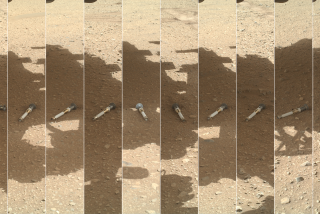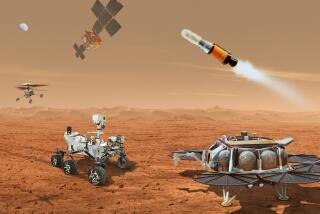NASA’s Mars 2020 rover to look for signs of life, help return samples
- Share via
NASA’s Mars 2020 rover may end up looking a lot like Curiosity, but its mission will be taking exploration of the Red Planet to the next level: looking for signs of past life.
In an announcement Tuesday, a panel of scientists and engineers outlined the planned robotic explorer’s potential goals and capabilities. According to a 154-page report by the Science Definition Team, the 2020 rover would collect soil and rock samples in a cache that could be picked up and ferried home by future missions. Its suite of instruments, to be chosen after a competitive process, would aim to look for “biosignatures,” or traces of life on the Red Planet.
“Had life been there, did it leave a mark?” said Jack Mustard, chairman of the Science Definition Team and a professor at Brown University.
Until now, NASA officials have been loathe to use such a loaded phrase as “traces of life.” The Curiosity rover, which landed on the Martian surface last year, was tasked with searching for habitable environments – places that have all the necessary chemical ingredients to make them hospitable for life. But looking for life itself? Even with the high-tech lab in its belly, Curiosity wasn’t built for such searches.
But the Mars Science Laboratory rover discovered habitable environments this year not far from its landing site in Gale Crater. With Curiosity’s successes, the next set of questions for the 2020 rover have changed, scientists said.
The 2020 rover is scheduled to cost about $1.5 billion, not counting the launch costs, said Jim Green, director of NASA’s Planetary Science Division. Officials hope to keep costs down by using the Curiosity rover as a template, using its chassis as well as its landing system (made famous by NASA’s “Seven Minutes of Terror” video). They may even use spare parts from the Curiosity rover, which is managed by Jet Propulsion Laboratory in La Canada Flintridge.
The landing site hasn’t been selected, but it should be in a habitable environment, where the rover will be able to extract core samples to store for analysis, officials said. The researchers said that the rover would be able to store up to 31 cores. There’s no way to get these hypothetical samples back to Earth just yet — the rover would be part of a multi-step plan to figure out a way to store the samples safely, send a spacecraft to retrieve them, and then blast off the surface of Mars before traveling safely back to Earth.
“Who knows, maybe [humans] will pick up the samples,” John Grunsfeld, NASA’s associate administrator for science, said in jest. At the moment, he said, there’s no clear road map for getting a robotic system set up to retrieve Martian samples, pointing out that there was no requirement that robots pave the way for astronauts.
However, he added, demonstrating the capability to send a robotic spacecraft to Mars that would grab the samples, launch off the surface and head back to Earth would be a definite advantage before putting humans on the line.
A robotic system would be a “definite plus if you were sending people ... assuming the people you send you want to bring back,” he joked.







